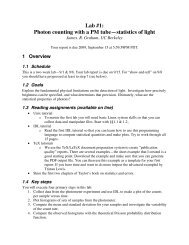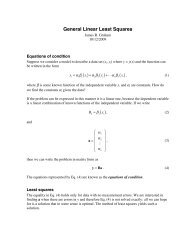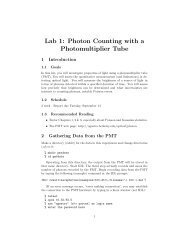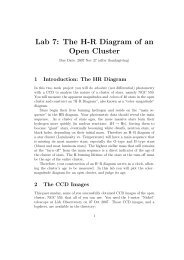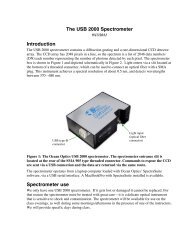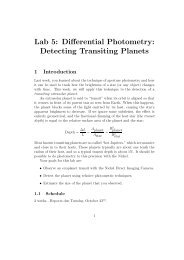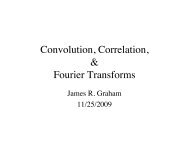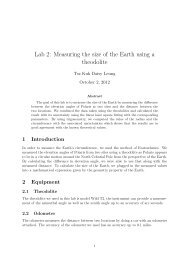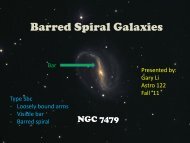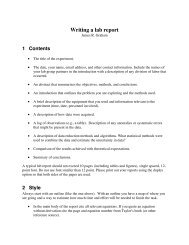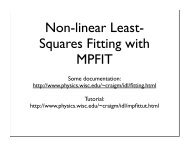Lab 6: Double Einstein Ring System SDSSJ0946+1006 - UGAstro
Lab 6: Double Einstein Ring System SDSSJ0946+1006 - UGAstro
Lab 6: Double Einstein Ring System SDSSJ0946+1006 - UGAstro
Create successful ePaper yourself
Turn your PDF publications into a flip-book with our unique Google optimized e-Paper software.
our bandpass (F606W). Using the distance modulus, we can calculate theabsolute magnitude, M g of the galaxy by 7 :( ) dM g = m g − 5log 1010pc(13)Where d, the distance to the lensing galaxy, was obtained using the measuredredshift to the galaxy and equation (3) to be 835.97 Mpc. This equationgives the absolute magnitude of the lensing galaxy in the F606W bandpassto be -21.830 mag. We can then calculate the luminosity of the galaxy in thebandpass, L g , in terms of the Sun’s luminosity, L J , using the equation:M g = M J − 2.5log 10(LgL J )(14)Where the absolute magnitude of the sun, M J , is known to be 4.76 mag.Solving for L g in this equation gives:L g = L J × 10 MJ −Mg2.5 (15)This gives the luminosity of the lensing galaxy in the bandpass to be4.329 × 10 10 L J . Note that this result is much smaller than if we assumethat the mass of the galaxy consists of entirely Sun-like stars (By a factorof 6.98). This is due to two factors: the first is that our first luminositycalculations does not take into account the fact that a large portion of thegalactic mass does not radiate in the same way as the sun (because some ofthe luminous matter might be non-stellar objects, such as hot gas, and mostof the stellar objects in the elliptical galaxy would be old, red stars). Thesecond factor is because most of the mass of the elliptical galaxy is in theform of non-luminous dark matter.The mass to light ratio of the lensing galaxy, defined as its mass in solarmass divided by its luminosity, can be calculated using the luminosity foundusing the second method to be 6.98±1.41 where the uncertainty follows fromequation (7). The mass to light ratio gives a picture of the amount of massthat does not radiate photons (at least within the bandpass). As such, it is7 Caroll & Ostlie, 1996: Modern Astrophysics, pg. 6820




